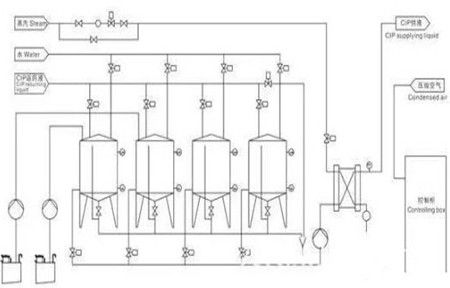
*** First water rinse
The first water rinse is also called “pre-washing”. It mainly washes away the material residue and viscous liquid in the equipment, container and pipeline to be cleaned as much as possible, so as to enter the washing (liquid) tank as little as possible. The water used for the pre-washing is generally discharged; in order to save water, the pre-washing water is often the recovered part of the post-washing water. Moreover, the front wash tank is generally large, and the pre-washing process takes about 10-15 minutes. The larger the equipment to be cleaned, the longer the flushing time. If the cleaning equipment used is simpler, for example using a ball washing method, the washing time is also longer.
*** Pickling or caustic washing
Alkaline washing or pickling The equipment is thoroughly cleaned with an alkaline detergent or an acidic detergent on the basis of the pre-washing. The residual organic matter adhered is removed, including viscous particulate residues such as starch granules, hop resin, protein, and pastes which heat the surface to be sintered, caramel and the like, as well as precipitated solids and the like. This washing process takes a long time and takes about 20-40 minutes. This is the main cleaning procedure for CIP cleaning. The real washing effect is mainly reflected in this process.
There are two aspects to this process:
The first is the so-called alkaline washing or pickling, not only using a certain concentration of alkali or acid, but a synthetic detergent containing a plurality of cleaning aids such as a surfactant, a water softener, a detergent, and a chelating agent. The choice of detergent depends on the ability and extent of the alkaline or acidic detergent to remove dirt and the environment being cleaned.
Secondly, the method of using alkali washing or pickling should be selected according to the object to be cleaned, and the method of cross-cleaning with alkali and acid can be used to meet the cleaning requirements. For example, when cleaning a large tank, it can be washed first with an alkali cleaning agent, and after the end, the residual alkali is washed, and then washed with an acidic detergent, and a better cleaning effect can often be obtained. When performing alkaline washing, the cleaning agent is heated to 80-85 ° C (or a suitable temperature), and when pickling, it is usually carried out at normal temperature. When causing alkaline washing or pickling, some dirt will be washed and some solid dirt will be taken out. Therefore, it is advisable to install a filter to filter out the particles before the alkali or acid is recycled into the corresponding storage tank, so that the detergent can be added. The number of reuses reduces the amount of deposits in the tank.
*** Second wash
The second water washing is also called "post-washing". After alkali washing or pickling, the alkali or acid remaining in the container and the pipe is rinsed off until the water that is flushed is neutral.
There are a few issues to be aware of when washing back:
First, in order to prevent the detergent from being diluted by water, it is necessary to recycle all the detergents before proceeding.
Second, in order to save water, most of the post-washing water can be recycled into the “pre-washing water tank” for the first flushing water (described above).
The third is to consider the need to save flushing water. It is necessary to neutralize with dilute acid or dilute alkali before washing. For hot alkaline washing, most of the water used for washing is also hot water, which not only has good washing effect, but also has good disinfection effect. Therefore, "post-washing" can be considered as the final step of CIP cleaning. For cold pickling, the post-washing water is mostly normal temperature water, and the aseptic conditions are very important. If the post-washing water contains bacteria, it is equal to secondary pollution, so it must be washed again with disinfectant water to meet the requirements; In the latter half of the post-washing rinse, the disinfectant is added online and then post-washed and disinfected.
*** Disinfectant rinse
Disinfectant rinsing is to ensure that the equipment and piping are further sterilized under cold pickling conditions, often after the end of washing, and then recirculated and washed with a suitable concentration of disinfectant solution. The selected disinfectant is preferably after rinsing, the residual liquid does not have any influence on the product, and does not cause corrosion to the equipment, such as peracetic acid, chlorine dioxide, hydrogen peroxide, etc., so that it is no longer necessary to use Repeat the rinse with sterile water. In order to ensure the quality of products and the safety of food, modern beer brewing strongly opposes the sterilization of large tanks, sake tanks and beer pipes with formaldehyde fungicides, because formaldehyde residues can cause drinking safety problems.
*** Washing with sterile water
Precautions for sterilized water rinse
First, the preparation of sterile water is relatively high, and the equipment including storage containers and pipelines must meet the aseptic conditions.
Second, if the aseptic state of the sterile water does not meet the requirements, the flushing effect is counterproductive.
The third is to extend the CIP rinse process time and increase the flushing water volume.